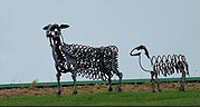8 Nature and culture
Let's look at some of the thinking that has informed our understanding of nature. Culture influences the way we understand nature. I want to illustrate this point with reference to the changing ways that people have viewed the Highlands and Islands.
Up until the 18th century, the rough and mountainous landscapes of the Highlands were considered to be wholly unappealing. In part this was political. The relative inaccessibility of the area meant that it was largely outside the political control of Edinburgh or London. However, it was also related to a taste for productive agricultural landscapes and rolling parks that echoed ancient Rome.
While we cannot pick on one factor to account for the fact of the change that saw these landscapes become considered as things of beauty, we can unpick a few historical trends. The military conquest of the Highlands meant it was much safer to travel in. The emergence of geology as a science saw an increased interest in wild places. As we conquered and subdued 'wild' nature, making it into agricultural landscape favoured by early landscape artists, so the interest in wild, sublime nature grew. Wild mountainous landscapes went from sites of fear — places that would corrupt the soul — to places of spiritual health and awakening (Hope Nicolson, 1959). This was coupled with an increased interest in 'native people' and was informed by European Romanticism.

